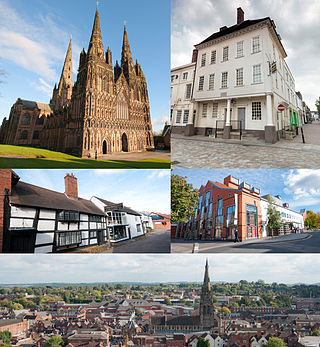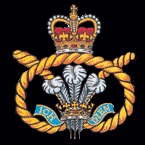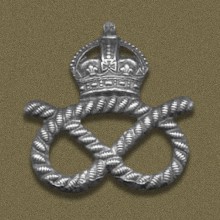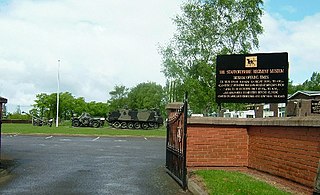
Lichfield is a cathedral city and civil parish in Staffordshire, England. Lichfield is situated roughly 18 miles (29 km) south-east of the county town of Stafford, 8.1 miles (13.0 km) south-east of Rugeley, 9 miles (14 km) north-east of Walsall, 7.9 miles (12.7 km) north-west of Tamworth and 13 miles (21 km) south-west of Burton Upon Trent. At the time of the 2021 Census, the population was 34,738 and the population of the wider Lichfield District was 106,400

The Staffordshire Regiment (Prince of Wales') (or simply "Staffords" for short) was an infantry regiment of the British Army, part of the Prince of Wales' Division. The regiment was formed in 1959 by the amalgamation of the South Staffordshire Regiment and the North Staffordshire Regiment (Prince of Wales'), and in 2007 was amalgamated with the Cheshire Regiment and the Worcestershire and Sherwood Foresters Regiment to become the 3rd Battalion, Mercian Regiment.

The South Staffordshire Regiment was a line infantry regiment of the British Army in existence for only 68 years. The regiment was created in 1881 under the Childers Reforms by the amalgamation of the 38th Regiment of Foot and the 80th Regiment of Foot. The regiment saw service in the Second Boer War, World War I and World War II.

Lichfield is a local government district in Staffordshire, England. It is administered by Lichfield District Council, based in Lichfield.

The 46th Division was an infantry division of the British Army, part of the Territorial Force, that saw service in the First World War. At the outbreak of the war, the 46th Division was commanded by Major-General Hon. E.J. Montagu-Stuart-Wortley. Originally called the North Midland Division, it was redesignated as the 46th Division in May 1915.

William Harold Coltman, was an English recipient of the Victoria Cross (VC), the highest award for gallantry in the face of the enemy that could be awarded to British and Commonwealth forces. He was the most decorated other rank of the First World War.

Sergeant John Carmichael was a British Army soldier and a Scottish recipient of the Victoria Cross (VC), the highest and most prestigious award for gallantry in the face of the enemy that can be awarded to British and Commonwealth forces.

The Mercian Regiment is an infantry regiment of the British Army, which is recruited from five of the counties that formed the ancient kingdom of Mercia. Known as 'The Heart of England's Infantry', it was formed on 1 September 2007 by the amalgamation of three existing regiments. The Regiment has had fifteen operational deployments since its formation.
The National Memorial Arboretum is a British site of national remembrance at Alrewas, near Lichfield, Staffordshire. Its objective is to honour the fallen, recognise service and sacrifice, and foster pride in the British Armed Forces and civilian community.
The Prince of Wales's Division was a British Army command, training and administrative apparatus designated for all land force units in the West of England and Wales. It merged with the Scottish Division, to form the Scottish, Welsh and Irish Division; at the same time the Mercian Regiment joined with the King's Division.

The Staffordshire Yeomanry was a unit of the British Army. Raised in 1794 following Prime Minister William Pitt's order to raise volunteer bodies of men to defend Great Britain from foreign invasion, the Staffordshire Yeomanry began as a volunteer cavalry regiment.
The 80th Regiment of Foot (Staffordshire Volunteers) was an infantry regiment of the British Army, raised in 1793. Under the Childers Reforms it amalgamated with the 38th (1st Staffordshire) Regiment of Foot to form the South Staffordshire Regiment in 1881.
The Mercian Brigade was an administrative formation of the British Army from 1948 to 1964. The Brigade administered the infantry regiments from the area of England between the Trent, Mersey and Severn rivers that roughly corresponded to the ancient kingdom of Mercia.

The North Staffordshire Regiment (Prince of Wales's) was a line infantry regiment of the British Army, which was in existence between 1881 and 1959. The 64th (2nd Staffordshire) Regiment of Foot was created on 21 April 1758 from the 2nd Battalion of the 11th Regiment of Foot. In 1881, under the Childers Reforms, the 64th Regiment of Foot was merged with the 98th (Prince of Wales's) Regiment of Foot (originally raised in 1824) to form the Prince of Wales's (North Staffordshire Regiment). In 1921 the regimental title was altered to the North Staffordshire Regiment (Prince of Wales's).
The 98th Regiment of Foot was an infantry regiment of the British Army. It was originally raised in 1824 as the 98th Regiment of Foot, before assuming the title of the 98th Regiment of Foot in 1876. Later, in 1881, following the Childers Reforms of the British Army, the regiment was amalgamated with the 64th Regiment of Foot to become the Prince of Wales's Regiment. As the 64th Foot was senior to the 98th, the 98th became the 2nd Battalion in the new regiment. Throughout the course of the regiment's existence it served mostly overseas in South Africa, China and India.

DMS Whittington, otherwise known as Defence Medical Services Whittington, is a military base in Whittington, Staffordshire, near Lichfield in England. It is home to the Staffordshire Regiment Museum, the Headquarters of the Surgeon General and subordinate medical headquarters, and the location of the Defence College of Health Education and Training.

The Mercian Trail is the name given to a group of museums and historical sites in the West Midlands of England that will be used to display objects from the Staffordshire Hoard. The trail is organised by a partnership of Lichfield District, Tamworth Borough Council, Staffordshire County Council, Stoke-on-Trent City Council and Birmingham City Council, and features the following locations:
Ernest Worrall (1898–1972) was an English artist and teacher. Born in London, he served in World War I and graduated from the Royal College of Art before moving to Grimsby. He is remembered for a series of paintings depicting the impact of World War II on the town. His work was exhibited in the Royal Academy fourteen times, and has more recently been displayed in the National Memorial Arboretum in Lichfield in response to a successful exhibition in a centre in Cleethorpes.

The Royal Tank Regiment Memorial is a sculpture by Vivien Mallock in Whitehall Court, London. It commemorates the Royal Tank Regiment.






















